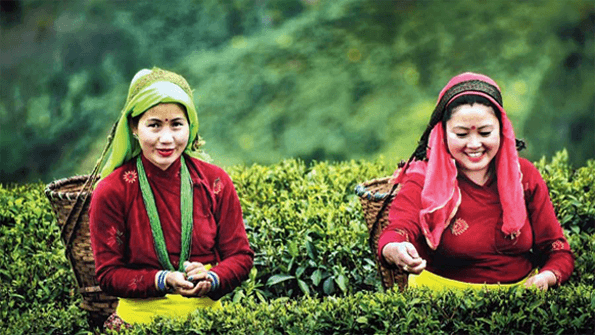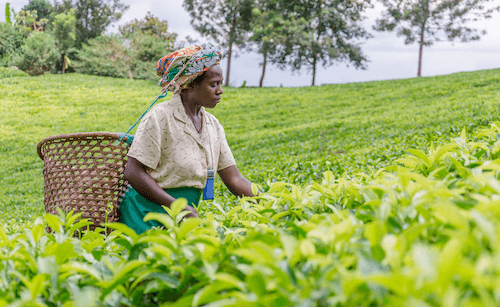
The region in North East India yields the uniquely wonderful tea, known all over the world as Darjeeling. But how did this small, hilly area become one of the most famous tea producers on Earth? There is no doubt that Darjeeling is a very special tea region. The area is known for producing the ‘Champagne of teas’ and is nestled in the foothills of the Indian Himalayas at an altitude of around 2,000 metres. It borders Nepal, Bhutan and Tibet and hilly tea gardens only produce teas in certain seasons – each season giving its own character to the teas.
The name ‘Darjeeling’ has an interesting story of its own. It is thought to have come from the Tibetan words ‘dorje’, meaning ‘thunder’, and ‘ling’, meaning ‘land’. So literally it means ‘land of the thunderbolt – referring to the sceptre of the deity Indra from Hindu mythology.
The story of Darjeeling becoming a tea growing region was influenced by China, England and Scotland. A Scottish explorer and botanist named Robert Fortune smuggled tea seeds from China nearly 200 years ago. The tea seeds were planted in the Darjeeling area as the English traders were wary about only having one supplier for their tea – China. The English traders wanted access to a source of tea which they could have full control over. These Chinese tea seeds, smuggled by a Scot and planted by English traders grew into the tea gardens which put the region on the map worldwide.
Darjeeling was chosen as an ideal location due to its cool weather and its topography. The quality of the tea produced from the area soon cemented Darjeeling’s reputation as a producer of exceptional quality teas.
In 1835 the British took control of Darjeeling and turned it into a premier hill station where the officials and their families could go during the summer to escape the intense Indian heat. When the British left India in 1947, the tea gardens were transferred to Indian entrepreneurs. In the 1960s, Darjeeling was transferred to West Bengal and this reign, under the communists, lasted about 35 years.In 2005, Darjeeling finally won protection under WTO as a Geographical Indicator which means that only tea that is grown in Darjeeling can be called Darjeeling. There are currently 87 tea gardens in Darjeeling, spread over 17,500 hectares and the region’s economy is heavily dependent on tea.

Tea was first cultivated in Uganda in the early years of the 20th century in the botanical gardens in Entebbe, the capital. The crop was a success and commercial cultivation of tea started in the 1920s. Tea is one of Uganda’s main exports and is grown by both plantation companies and small holder farmers. The tea industry employs more than 60,000 people and supports the livelihood of over half a million people. The majority of Uganda’s tea is finds its way to international markets through the Mombasa Auction where they are then used for teabag blends.
Uganda is endowed with a comparable soil, altitude and climate to that of Kenya. It receives plenty of sunshine and abundant rainfall. Unfortunately, Uganda’s tea industry was decimated by political upheaval in the 70s. Bushes became trees and factories became empty shells. By 1981, Uganda was producing just 5% of the tea it made in 1974.
Uganda’s tea industry came back from near ruin to be stronger and play a vital role in Uganda’s economy. Commonwealth development money, foreign expertise and investment by Indian companies all helped to rehabilitate the tea industry. In 2018, Uganda produced 50 million kg of tea, making it the second largest producer in Africa after Kenya.
Tea is largely grown along the Lake Victoria crescent, the lower slopes of the Rwenzori Mountain (1200-1800 metres above altitude) and above the Western Rift Valley. Tea leaves are harvested either by hand or by shears. Their liquors are of average quality but their leaf is very clean, blackish, grainy and dense.
If you are a retail food and drinks buyer and are looking for some advice on how to introduce new products and retail experiences into your shop, this blog is for you.
2020 was a year like no other and 2021 is continuing to test and challenge us in ways we couldn’t even imagine a couple of years ago. All our lives have been impacted: how we live, travel, communicate and socialise.
The coronavirus pandemic has even had a massive impact on how we shop for food and drinks products and what products consumers are interested in. In the short term, spend may be diverted from coffee shops and restaurants to retail sales and this will fuel a premiumisation trend in retail. Coronavirus has actually given tea and other hot drinks a healthy boost due to remote working, continued safety concerns and cautious spending habits.
The coronavirus pandemic has even put into focus what we eat. Sales of products considered to be healthy or healthier are seen to be more attractive to consumers. Also consumers are more interested in self-care and tea is increasingly part of that routine.
The functional benefits of tea continue to be a growing focus for consumers. Another impact of Coronavirus is that consumers are turning to food and drink products to help them manage stress or aid a good night’s sleep. It’s worth thinking about whether your tea aisle reflects this interest.The types of tea consumers’ drink continue to evolve. Black tea continues to be the go-to drink for tea lovers. In the UK, nearly three quarters of adults (73% (Mintel July 2020)) drink black tea, however the sales of green and herbal teas continue to climb especially within the foodie community.
In pre-coronavirus times, if you were a food and drinks buyer who was on the prowl for some new innovative products, all you needed to do was to go to one of the well-known food and drinks trade shows. Now, in the new normal, in-person events are off the menu, excuse the pun! If you are looking for some inspiration on how to find the new enticing products for your customers, we’ve put together some socially distanced and safe ideas for you below on how to find the best new products that your customers will love.